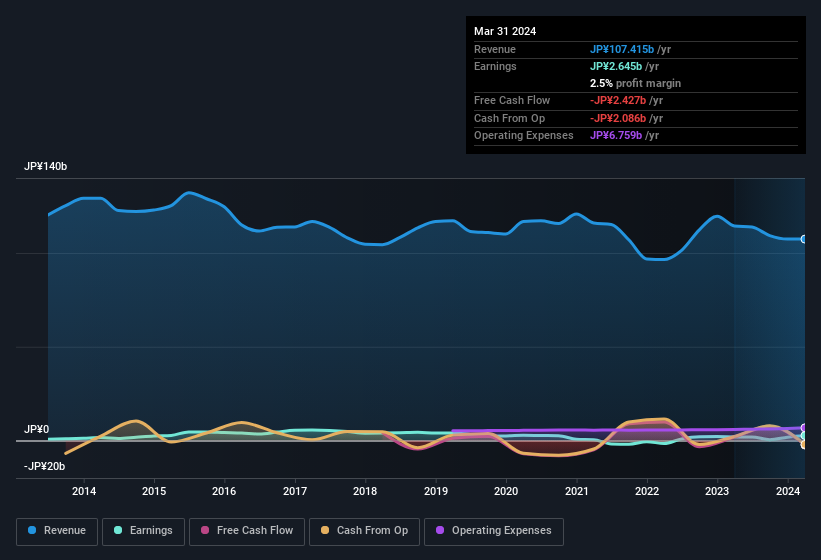- Japan
- /
- Construction
- /
- TSE:1827
We Think That There Are Some Issues For Nakano (TSE:1827) Beyond Its Promising Earnings

The stock price didn't jump after Nakano Corporation (TSE:1827) posted decent earnings last week. We did some digging and believe investors may be worried about some underlying factors in the report.
View our latest analysis for Nakano

A Closer Look At Nakano's Earnings
One key financial ratio used to measure how well a company converts its profit to free cash flow (FCF) is the accrual ratio. The accrual ratio subtracts the FCF from the profit for a given period, and divides the result by the average operating assets of the company over that time. You could think of the accrual ratio from cashflow as the 'non-FCF profit ratio'.
Therefore, it's actually considered a good thing when a company has a negative accrual ratio, but a bad thing if its accrual ratio is positive. While having an accrual ratio above zero is of little concern, we do think it's worth noting when a company has a relatively high accrual ratio. To quote a 2014 paper by Lewellen and Resutek, "firms with higher accruals tend to be less profitable in the future".
For the year to March 2024, Nakano had an accrual ratio of 0.37. As a general rule, that bodes poorly for future profitability. And indeed, during the period the company didn't produce any free cash flow whatsoever. In the last twelve months it actually had negative free cash flow, with an outflow of JP¥2.4b despite its profit of JP¥2.65b, mentioned above. It's worth noting that Nakano generated positive FCF of JP¥1.8b a year ago, so at least they've done it in the past.
Note: we always recommend investors check balance sheet strength. Click here to be taken to our balance sheet analysis of Nakano.
Our Take On Nakano's Profit Performance
As we discussed above, we think Nakano's earnings were not supported by free cash flow, which might concern some investors. For this reason, we think that Nakano's statutory profits may be a bad guide to its underlying earnings power, and might give investors an overly positive impression of the company. The good news is that, its earnings per share increased by 38% in the last year. Of course, we've only just scratched the surface when it comes to analysing its earnings; one could also consider margins, forecast growth, and return on investment, among other factors. So if you'd like to dive deeper into this stock, it's crucial to consider any risks it's facing. For example, Nakano has 4 warning signs (and 2 which shouldn't be ignored) we think you should know about.
This note has only looked at a single factor that sheds light on the nature of Nakano's profit. But there is always more to discover if you are capable of focussing your mind on minutiae. For example, many people consider a high return on equity as an indication of favorable business economics, while others like to 'follow the money' and search out stocks that insiders are buying. While it might take a little research on your behalf, you may find this free collection of companies boasting high return on equity, or this list of stocks with significant insider holdings to be useful.
Valuation is complex, but we're here to simplify it.
Discover if Nakano might be undervalued or overvalued with our detailed analysis, featuring fair value estimates, potential risks, dividends, insider trades, and its financial condition.
Access Free AnalysisHave feedback on this article? Concerned about the content? Get in touch with us directly. Alternatively, email editorial-team (at) simplywallst.com.
This article by Simply Wall St is general in nature. We provide commentary based on historical data and analyst forecasts only using an unbiased methodology and our articles are not intended to be financial advice. It does not constitute a recommendation to buy or sell any stock, and does not take account of your objectives, or your financial situation. We aim to bring you long-term focused analysis driven by fundamental data. Note that our analysis may not factor in the latest price-sensitive company announcements or qualitative material. Simply Wall St has no position in any stocks mentioned.
About TSE:1827
Nakano
Engages in the construction and real estate business in Japan, Singapore, Malaysia, Indonesia, Thailand, Vietnam, and internationally.
Solid track record with excellent balance sheet.
Market Insights
Community Narratives




